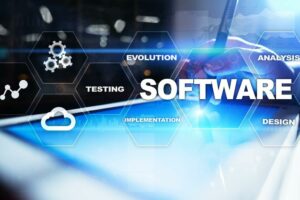Custom corporate resource planning software is becoming popular among CEOs who value efficiency and effectiveness. A key ERP principle is the central collection of data for wide distribution. With a secure and centralized data repository, everyone in the organization can be confident that data is correct, up-to-date, and complete. Data integrity is assured for every task performed throughout the organization, from a quarterly financial statement to a single outstanding receivables report, without relying on error-prone spreadsheets. Enterprise resource planning (ERP) manages and integrates business processes through a single system. With a better line of sight, companies can better plan and allocate resources.
Programming managers are responsible for maintaining legacy systems in traditional languages while developing systems in newer languages. They must also find ways to keep track of all the program modules and ancillary files that make up an application enterprise systems definition when several programmers work on a project. Stand-alone version control and configuration management programs handle this, and parts of these systems are increasingly built into the development systems themselves (see configuration management).
What’s the difference between ERP and financials?
According to Oracle NetSuite “, Each ERP module is designed for specific business functions, providing the data, and supporting the processes that will help those employees do their jobs. Every module plugs into the ERP system, so the system provides a single source of accurate data, even as the business adds new modules. If the ERP system is the toolbox, the modules are the screwdriver, wrench, hammer, and other tools in the box that each has specific uses.

Thanks to advanced data analytics tools, it is possible to optimize resource allocation and energy consumption. Marketo offers highly effective automation and lead generation tools, as well as instruments for enhanced customer communication and the creation of unique promotional campaigns. Predictive analytics based on artificial intelligence helps create personalized content for each customer. AWS is currently officially collaborating with SAP and Oracle so companies can run SAP and Oracle software on AWS. More than 5,000 SAP customers run their workloads using SAP on AWS, a collection of several tools and services to build robust, reliable, and scalable SAP systems on AWS infrastructure across the world.
A brief history of ERP
One should not try to control the enterprise like one would in a TSE effort at the project level. The ultimate goal of a Programme is to realise outcomes and benefits of strategic relevance. The optimization debate can be handled as described in the book called „Enterprise Architecture as Strategy“ (Ross, Weill, and Robertson 2006). In other words, an enterprise can choose (or not) to unify its operations and can choose (or not) to unify its information base. There are different strategies the enterprise might adopt to achieve and sustain value creation (and how ESE helps an enterprise to choose). This is further addressed in the section on Enterprise Architecture Formulation & Assessment in the article called Enterprise Capability Management.
- Enterprise resource planning (ERP) is a platform companies use to manage and integrate the essential parts of their businesses.
- One of the key benefits of an EMS is the reduction in the number of people needed to support complex IT infrastructure and business operations, as it’s all bundled into one package and is therefore much easier to manage across the business.
- To overcome such difficulties, in recent years, many organizations have opted to replace several distinct information systems with a single integrated system that can support business activities for different business functions.
- Digital systems help organizations increase the efficiency of their activities, control the work of different departments better, share knowledge and enhance transparency in business processes.
- While Enterprise System are by and large packaged enterprise application software (PEAS) frameworks they can also be, specially developed systems made to bolster a particular organization’s requirements.
It touches every facet of a modern enterprise, from customer service to operations, to social media, and to security. Over time, technology creates new jobs like mobile application developers, social media and business intelligence analysts, information security specialists, and data architects. Information technologies that integrate business functions across the enterprise, known as Enterprise Systems, have become the backbone of modern organizations. Enterprise information systems provide a technology platform that enables organizations to integrate and coordinate their business processes on a robust foundation.
Improve Supply Chain Management
The business processes in each business function were disparate and not capable of sharing information with each other. It was difficult for the managers to assemble the data fragmented into separate systems in order to present an overall picture of the organization’s operations and take firm-wide decisions. Unique customers’ needs may combine distinct aspects of enterprise platforms. Hundreds of enterprise software apps are waiting to be put to work to increase your company’s revenue.

With information about existing and potential clients in one place, businesses can personalize their communications and build deeper relationships. They can also bring together data from different departments to build out their sales pipelines and make financial forecasts. There are several different types and brands of enterprise software available.
Application Development/Configuration Management
Ultimately, the ability to streamline the supply chain means that products are delivered to customers more reliably, and at a lower cost, than would otherwise be possible. Using an Enterprise Resource Planning (ERP) system can be a major benefit for companies looking to streamline their customer service experience. ERPs allow businesses to automate their customer service process, which helps ensure that each employee is giving customers a consistent experience, and also ensuring that back office functions are as streamlined as possible. Automation saves time, which can then be used towards efforts to respond to customer requests for product information and to forecast for new products. If employees are spending less time on tracking down a customer’s order, they can spend more time developing long-lasting, profitable customer relationships. Which ones are the main applications depends on the business and the industry it operates in.

With the help of enterprise resource planning systems, information can flow seamlessly across the firm. Also, different business processes from sales, production, manufacturing, logistics, and human resources can be integrated into organization-wide business processes. This means that software and applications can be accessed anywhere, and at any time. It also means that there are less physical requirements in terms of servers and data centers. Cloud based applications are very cost effective for businesses that don’t want to purchase IT related hardware of their own.
Operating Systems
Financial value is not usually a direct outcome from the implementation of an enterprise information system. MRP remained the manufacturing standard until manufacturing resource planning (called MRP II) was developed in 1983. MRP II featured “modules” as a key software architectural component, and integrated core manufacturing components including purchasing, bills of materials, scheduling, and contract management.

ERP software also provides total visibility, allowing management to access real-time data for decision-making. With third-party integrations it is possible to make payment transactions safer, faster, and easier. With https://www.globalcloudteam.com/ these services, the program can adjust to large-scale business needs without decreasing high standards of performance. SaM Solutions provide effective automation and seamless security for your enterprise software.
Resources
Because of the mobile platforms and decentralized workforce–work anywhere and anytime–ERP systems can no longer be tied to yesterday’s on-premises back-office applications. The next-generation, cloud-based, and modern ERP solutions support the new industry dynamics while providing the ability to reduce support time to enable organizations to respond quickly to volatile markets and industry trends. How can these solutions manage organizations day-to-day business activities, such as accounting, finance, procurement, project management, supply chain, and manufacturing.

